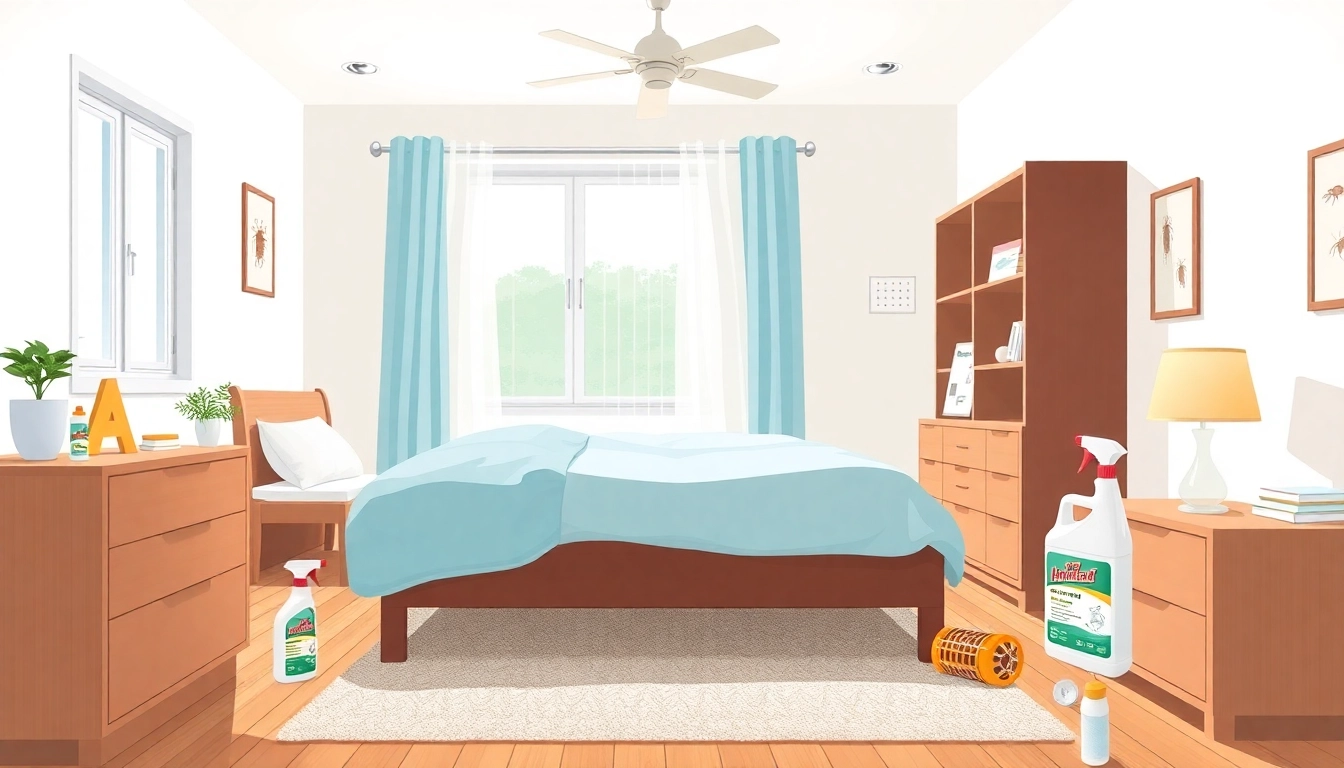Understanding Bed Bugs: An Overview
What are Bed Bugs?
Bed bugs are small, wingless insects belonging to the family Cimicidae. They thrive on the blood of humans and animals, making them a pest that can invade homes, hotels, and many other environments. Adult bed bugs are typically reddish-brown, about the size of an apple seed, and can be easily mistaken for other pests. Unlike some insects, bed bugs do not carry diseases, but their presence can cause distress, anxiety, and skin reactions due to bites. Understanding their biology and behavior is crucial for effective bed bug pest control.
Common Signs of Infestation
Identifying a bed bug infestation early is vital. Common signs include:
- Visible Bugs: Adult bed bugs and their eggs can often be found in the seams of mattresses, bed frames, and nearby furniture.
- Bed Bug Bites: Red, itchy welts on the skin, typically in a line or cluster, are key indicators of bed bug bites.
- Fecal Spots: Dark, rust-colored spots on sheets and mattresses are dried excrement from bed bugs.
- Molted Skins: As bed bugs grow, they shed their exoskeletons, which can be found in infested areas.
The Bed Bug Life Cycle
The life cycle of bed bugs consists of several stages: egg, nymph, and adult. Female bed bugs can lay hundreds of eggs in their lifetime, with each egg hatching in about 7 to 10 days. Nymphs undergo five molts before becoming adults, feeding on blood during each stage. A complete life cycle can take about 5 weeks under favorable conditions, leading to rapid population growth if not controlled promptly.
Effective Bed Bug Pest Control Methods
Chemical Treatments: Insecticides and Pesticides
Chemical treatments are one of the most common and effective methods for controlling bed bugs. Pest control professionals often use pesticides that target bed bugs at various life stages. Key points to consider include:
- Types of Insecticides: Pyrethroids and neonicotinoids are commonly used insecticides. Pyrethroids are designed to attack the nervous system of insects, while neonicotinoids imitate nicotine, affecting the insect’s neurological function.
- Application Methods: Insecticides can be applied as sprays, dusts, or aerosols. Professional exterminators are trained to apply these chemicals safely and effectively.
- Integrated Pest Management (IPM): Chemical treatments are more effective when combined with IPM strategies, which include monitoring, prevention, and sanitation practices.
Non-Chemical Treatments: Heat and Cold Techniques
Non-chemical treatments have gained popularity for their effectiveness and minimal environmental impact. These methods include:
- Heat Treatment: Raising the temperature in infested areas to 120°F (49°C) or higher can kill bed bugs and their eggs within minutes. This method is particularly useful in homes and hotels, where furniture can also be treated.
- Cold Treatment: Freezing infested belongings at temperatures below 0°F (-18°C) for at least 4 days can effectively eliminate bed bugs. This method is suitable for smaller items that can be packed and placed in a freezer.
Integrated Pest Management (IPM)
IPM combines multiple strategies to create a comprehensive bed bug control plan. Key elements include:
- Monitoring: Regular inspections help identify bed bug activity early. This may involve using bed bug monitors or interceptors.
- Sanitation: Keeping living areas clean reduces hiding spots for bed bugs. Regular vacuuming, washing linens in hot water, and decluttering is crucial.
- Education: Informing residents about bed bug prevention strategies is key in maintaining a bed bug-free environment.
Preparing Your Home for Bed Bug Extermination
Steps to Take Before Treatment
Preparation is essential for effective bed bug extermination. Before treatment, residents should:
- Identify Infested Areas: Perform a thorough inspection of all rooms to determine the extent of the infestation.
- Report to Professionals: Share findings with pest control professionals to tailor treatment plans appropriately.
- Remove Clutter: Clear clutter from infested areas to enhance treatment effectiveness. Items should be washed, sealed, or stored away.
Cleaning and Decluttering
A clean environment not only aids in the effectiveness of extermination methods but also helps prevent future infestations. Important practices include:
- Vacuum Thoroughly: Vacuum all surfaces, including carpets, upholstery, and mattresses. Be sure to empty the vacuum after use to prevent bed bugs from escaping.
- Wash Fabrics: Launder all bedding, linens, and clothing in hot water, then dry on high heat to kill any hidden bugs.
- Seal Items: Use plastic bags to seal items that cannot be washed, preventing bed bugs from accessing these items during treatment.
Protecting Your Belongings
To ensure belongings are safe during extermination:
- Use Protective Covers: Encapsulate mattresses and box springs with bed bug-proof covers to trap any existing bugs.
- Store Belongings Wisely: Keep personal items in sealed plastic containers to prevent re-infestation and to protect during the treatment.
- Consult with Professionals: Ask pest control experts for specific recommendations on how to protect belongings in your home.
Post-Treatment: Maintaining a Bed Bug-Free Environment
Ongoing Monitoring and Prevention
After treatment, it’s critical to monitor and maintain your environment to prevent re-infestation. Consider the following:
- Regular Inspections: Conduct routine checks, especially after traveling or acquiring used furniture, ensuring you catch any potential issues early.
- Use Monitors: Bed bug monitors or traps can be placed around beds and furniture to detect any returning infestations quickly.
Best Practices for Prevention
To keep bed bugs at bay, adopt these prevention practices:
- Be Cautious with Used Items: Inspect used furniture and clothing before bringing them into your home.
- Stay Vigilant When Traveling: Check hotel rooms and luggage for signs of bed bugs to ensure you do not bring them home.
- Seal Cracks and Crevices: Close off areas where bed bugs can hide, such as wall cracks and around electrical outlets.
Signs to Watch For After Treatment
Even after treatment, remain vigilant for recurring signs of bed bugs:
- Increased Bites: If you notice new bites on your skin, it may be a sign of surviving bugs.
- Resurfacing Fecal Spots: Dark spots appearing on bedding or furniture may indicate continued activity.
- Finding Eggshells: If you find eggshells or shed skins, this could mean that the infestation has lingered.
Choosing a Professional Pest Control Service
What to Look For in a Pest Control Company
Selecting the right pest control service is paramount in achieving effective bed bug extermination. Consider the following factors:
- Licensing and Certification: Ensure the company is licensed and has qualified professionals who are trained in pest management.
- Experience and Expertise: Look for companies with specific experience in bed bug treatments, as well as a proven track record of success.
- Technique Variety: A good pest control service will offer a range of treatment options, including chemical and non-chemical methods, and discuss them with you transparently.
The Importance of Reviews and Recommendations
Reviews and testimonials can offer insights into the efficacy of a pest control service. Consider the following:
- Online Reviews: Check trusted review websites, social media platforms, and local forums for feedback from former customers.
- Word of Mouth: Ask friends and family for recommendations based on their experiences with pest control companies.
Cost Considerations for Bed Bug Pest Control
The cost of bed bug pest control can vary significantly, influenced by factors such as:
- Extent of Infestation: The size and severity of the infestation will dramatically affect treatment costs, with larger problems requiring more resources.
- Type of Treatment: Chemical treatments may be less expensive than heat treatments, but the latter might be more effective for severe infestations.
- Follow-Up Treatments: Some pest control companies may charge for follow-up visits, so it’s essential to understand the pricing structure before committing.



